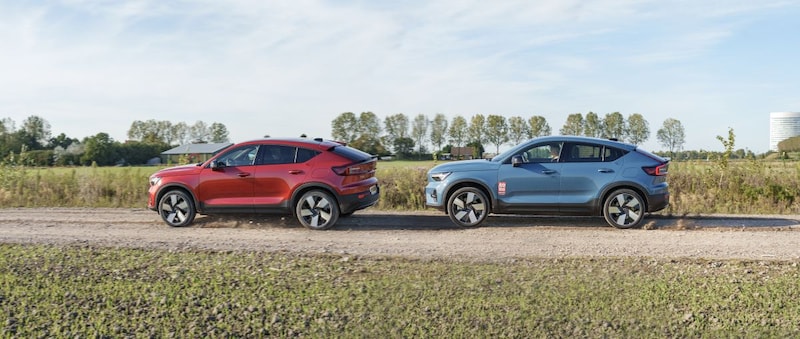From front to back

Because the Volvo C40 Recharge with one electric motor was rear-wheel drive instead of front-wheel drive, we thought it was a good idea to include it in the endurance test fleet. We still took a C40 from before the update to our Single Motor endurance tester to really experience the improvements.
With the Volvo C40 Recharge with front-wheel drive, you can clearly feel the 231 hp electric motor releasing the forces on the front wheels. If you switch from our rear-wheel drive endurance tester, it’s a bit like switching from a mid-motor electric bicycle to an electric bicycle with the motor in the front wheel. You feel more pulled along than pushed. The reactions on the accelerator pedal are more intense, which you notice in the nose that rises a bit, and on wet roads you will spin if you accelerate too roughly. The rain poured down in the week that we drove the front-wheel drive version next to the endurance tester, so the conditions to experience the difference were ideal. There is more unrest in the first batch of C40’s Single Motor, which you could of course also order as a Twin Motor, with the two electric motors generating 408 hp. When it can properly use the power on a dry road surface, the 231 hp Single Motor feels just as fast as the 252 hp C40 Single Motor Extended Range that we drive, which has a larger, therefore heavier battery pack. Only he adds more drama, with reactions in the nose and handlebars. The electric motor seems to hang a little looser in the nose. Regeneration also feels more abrupt.

The new basis for the Volvo C40 Recharge with Single Motor. So it’s in the back.
New electric motor
Is the C40 more refined due to the move of the electric motor? Certainly, the rear wheels sometimes have a bit of a hard time on wet roads, only in bends, but you don’t notice anything about the drive response of the steering wheel. The car really drives better. By the way, the electric motor in the newer version is of a different type. This now concerns a so-called electric motor with permanent magnet, an electric motor that Volvo has developed in-house and also produces itself. This could be optimally matched to the control software written by Volvo.

The old basis for the Volvo C40, as it was presented for the Volvo 40.1 and 40.2 Concepts, which eventually became the XC40 and the Polestar 2.
New one is more economical
The new C40 is also more efficient. In the week that we drove the old and the new side by side, we saw consumption figures turn out in favor of the rear-wheel drive. The endurance tester consumed 18.7 kWh/100 kilometers during that period, the front-wheel drive unit consumed 19.8 kWh/100 kilometers. That was at an outside temperature between 11 and 14 degrees. The old version has a net battery capacity of 67 kWh and has a range of 350 to 370 kilometers. The new C40 does the same content if you choose the basic version, but goes further thanks to the more economical electric motor. The WLTP specification for the range is 478 kilometers and for the front-wheel drive Volvo specified 434 kilometers. The power also increased slightly. Now the C40 has at least 238 hp, while the red car in this story produces 231 hp. The Extended Range variant (which did not exist before the update) that we drive delivers 252 hp, has a net battery capacity of 78 kWh and should travel 581 kilometers according to the WLTP statement. In the first weeks we still had 470 practice kilometers. Now that it is colder and an autumn storm arises every now and then, the range is 400 kilometers.
– Thanks for information from Autoweek.nl